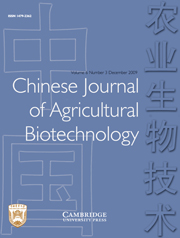No CrossRef data available.
Article contents
Analysis, gene cloning and expression of two α-amylases from Bacillus cereus
Published online by Cambridge University Press: 30 October 2009
Abstract
Bacillus cereus can produce α-amylase, which has important industrial production value and can endure high temperatures. The enzymatic characteristics of two α-amylases from B. cereus (B905 and B904) were studied. The results showed that both preserved their activity at 90–100°C. Their thermal stability and enzymatic activity did not depend on Ca2+. However, their protein molecular weights were obviously different. The structural genes of amy905 and amy904 were cloned successfully using the polymerase chain reaction (PCR) and expressed in Escherichia coli. The amy904 and amy905 genes were 1362 bp and 1761 bp long and their protein molecular weights were about 55 kDa and 68 kDa, respectively.
Information
- Type
- Research Papers
- Information
- Copyright
- Copyright © China Agricultural University 2009

